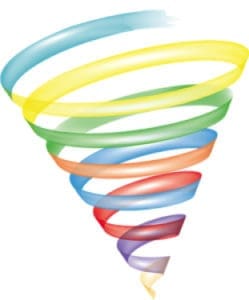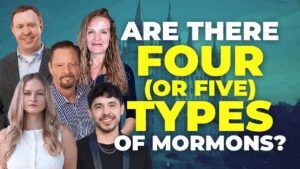 Spiral Dynamics is a data-based, psychological theory of how human consciousness changes the world, and explains how people come to very different conclusions while having access to the same information.
Spiral Dynamics is a data-based, psychological theory of how human consciousness changes the world, and explains how people come to very different conclusions while having access to the same information.
With panelists Jamie Hanis-Handy, Gina Colvin, Lindsay Hansen Park, and Glenn Ostlund, this is a conversation that attempts to build on an episode of The Liturgists and discusses how Spiral Dynamics may impact the future of Mormonism. Our listeners may visit this site for visual aids and a written description of Spiral Dynamics, including a history for how the theory came about.
Part 1:
Part 2:
Part 1:
Part 2:




20 Responses
I’m just 20 minutes into part 1, but I just have to say that letting Glenn bring in some of his editing was the best thing to ever happen on Mormon Stories.
Really? Best thing ever? Wow!
The editing on Infants on Thrones has always been a critical differentiator from them to virtually all the other Mormon sphere podcasts (and I know that they get ideas from non-Mormon podcsts, but I don’t listen to too many of those) — it just makes the podcast more dynamic than a straight panel discussion.
So yeah, it probably took a bit of work, but I’d definitely keep that style on if possible in the future.
Jamie mentioned (and I’ve heard it on Mormon podcast recently) that members are now assigned Gen Conf talks for their Sacrament Meeting talks. This must be a regional thing because I’m in a bishopric in Connecticut and I’ve never been told by my bishop or stake president to assign members Gen Conf talks as their source for their Sacrament Meeting talks.
Fantastic, I saw Spiral Dynamics & Altitudes of Development chart but I was having a hard time interpreting and internalizing it. This did a great job of doing that which will allow me to have a chance to becoming (Yellow or Turqoise)
I really enjoyed this podcast. Here were several thoughts that came to mind as I listened:
1. In my observation, I think that individuals, organizations, cities, states, countries (really any social organization) will spiral through these phases of development. During a person’s life, they would likely be drawn to other individuals, groups and/or organizations that are similar to their level of consciousness. When there becomes too large of a “gap” between the individual’s and the group’s level of consciousness, a parting of ways tends to naturally occur.
2. As a corollary to point #1, I see the cycling between the focus on the individual and the focus on the group or community as a critical part of development. The group can support and strengthen the individual as the individual grows and develops. But once the individual expands consciousness beyond that of the color they’re at, the individual tends to find a new group that matches the newer level of consciousness. But that individual’s leaving invites the group to do introspection (hopefully) and helps the whole group move upward (though this pace may be much slower than for the individual).
3. I think an individual can be at one color of consciousness in one area of his/her life and be at another color in another area of life. I’ve noticed that within myself and have tried to use mindfulness to try and bring the various levels within myself into more harmony and similarity with each other.
This was my first introduction to the concept of “Spiral Dynamics,” and with an all-star cast, too. Thanks, guys. This was a fun and thought provoking podcast to watch.
Some of it reminds me a little of Fowler’s stages of faith — blue, orange, and green = stage 3, 4, & 5, and maybe yellow and/or turquoise = stage 6? More or less…?
Yeah, I think blue is meant to correlate well with stage 3, orange with 4, but it’s a little trickier after that, because theres too many additional colors.
The beauty and use of color is quite amazing in this world, and how it is revealed in nature, art, and in describing behavior in a symbolic form. Thanks for this presentation and insights.
Even in other aspects of life, and in particular the arts, we see that musicians sometime refer to certain qualities of sound as a color, and the painter has referred to art as frozen music. We sometimes refer to people as having “colorful personalities”…..I wish there were more colorful personalities in the church. I think there actually are many, but there voices remain silent, or they have left, or they are attempting to make a difference as each of you in this group….thank you!
White, was not referred to, perhaps because it is the absence of color. There was some reflection on what color or colors were the end goal, for the perfect world. Turquoise? White? A Rainbow? From a color theory standpoint, it is interesting that all different complexions and colors of people supposedly look good in Turquoise, and that color seemed to be along the more advanced state, as referred to near the end of the presentation.
This leads me to my final thought about where these dynamics lead in the symbolism of the highest ideal in Mormonism… the Temple, and the Celestial Room. The idea of the highest level of spiritual existence would be represented with the sterelity of all white is rather sad to me. Even in LDS scripture this celestial world is referred to as “a sea of glass”!….also a lack of color! No thanks! The attempts to one-up this beautiful world fall flat, and don’t instill inspiration. How motivating is the statement, that “if we knew how wonderful heaven was, we would want to kill ourselves”! That’s another no thanks! I can imagine God being much happier surrounded by the colors in Nature, including those revealed by the Hubble Telescope pictures of the heavens, and that such is the place that the spiral of eternal progression would lead to….beautiful places with all mixures of colors, including white. As I recall, we supposedly “shouted for joy” to Experience this Third Stone From the Sun.
White light is the unbroken wholeness of all the color spectrum together. You get colored light by breaking, or refracting white light in a way that the human eye is able to see, and the human mind to perceive it as such. Sunlight is white light. We see the world in all its refracted, colorful glory, because of sunlight. The brilliant richness, the juicy subtlety, of the visual aspect of the world is only the dance of white light, playing in a billion refractive caresses over the surfaces and sometimes through the substances of physical creation.
The white most of us perceive (such as on temple clothing, or blank paper) is the portion of the spectrum reflected to our eyes by the objects’ surfaces. Our minds tend to register this “white” as an absence of “color”. Artists, though, trained to allow themselves to notice color in a more open, dynamic way, can show through their work that white is incredibly color-active. In fact, white is my favorite to paint, because it’s so excitingly rich with reflected colors and mysteriously complex shadow areas. But this is still not white light.
In this sense, I can think of no more appropriate metaphor for the supposed glory of Heaven, than white light.
However, I have to agree that if Heaven is like the sterile, dry, blank experience that is the Temple, then I’ll stick with this “telestial” sphere, thanks anyway.
I let my female friend listen to this podcast and asked her for her analysis on spiral dynamics .
She said .
“Ahhh it’s all just a beautiful colourful rainbow “
Oh she’s blonde by the way .
pantheist epistle
Can a color by any other name look the same?
1, a tan
2, b. plum
3, c. strawberry
4, d. aquamarine
5, e. peach
6, f. emerald
6, g. damdelioan
7, f. cerulean
8, g. salmon
now that’s better, the letters haven’t changed while the colors are much more vibrant and more easily remembered.
Glenn’s peach color is (5, E) YES it is there by another hue.
It’s like a pop quiz with no distinction.
Pop being the ongoing effort to scratch an unlocatable itch.
Colors, colors, we don’t need no stinking colors we got letters and numbers.
https://infantsonthrones.com…
QED
pantheist epistle
Can a color by any other name look the same?
1, a tan
2, b. plum
3, c. strawberry
4, d. aquamarine
5, e. peach
6, f. emerald
6, g. damdelioan
7, f. cerulean
8, g. salmon
now that’s better, the letters haven’t changed while the colors are much more vibrant and more easily remembered.
Glenn’s peach color is (5, E) YES it is there by another hue.
It’s like a pop quiz with no distinction.
Pop being the ongoing effort to scratch an unlocatable itch.
Colors, colors, we don’t need no stinking colors we got letters and numbers.
https://infantsonthrones.com/the-religion-of-science-part-1/
https://infantsonthrones.com…
QED
Heavy thinking for us simple folk…I feel I am thinking in the yellow range but not quite there yet in my behavior. Good thoughts and information to distill… thanks for the podcast and it’s good to be given some education along our journey…made me think of one of the 7 habits…seek to understand before being understood…
I’m surprised that Ken Wilbur’s Integral Theory did not come up in this discussion. Our own local celebrity Thomas McConkie would have much to contribute here as well. Carol Gilligan has also done important work with stages- egocentric, ethnocentric, world centric and integrated. These are new levels of consciousness that are exciting to explore. After leaving mormonism 10 years ago, I was very comfortable being in the secular world with no belief system. I’ve recently found myself feeling born again into God looking for oneness. I really never thought that would happen. I wonder if this is a normal transition (or spiraling) after having some space and time away from an orthodox belief system?
Is the Spiral Dynamics another way of understanding what Mormons call “degrees of glory”? For example, beige is the telestial kingdom, purple goes into levels within the terrestrial, and etc. ? This seems to validate D&C 76, that there is an eternal place for each color type of personality. What do you think?
Thanks!
This was a great discussion about human behavior. Humans have instincts like all other animals, but we are the only animal with consciousness (ability to self adjust). For example, birds migrate; they don’t know why migrate, they just do it. With humans our consciousness is sometimes at odds with our instinct. This conflict between instinct and consiousness casues humans to be frustrated, mean etc. This is not the same as ID and EGO. It is opposite. We were born with instincts to love and be empathetic, and our consciouness is the source of the human condition.
If you really want to understand how people think and the human condition, try this. The understanding you get from this explanation of the human condition explains human behavior.
“I have no doubt FREEDOM provides the holy grail of insight we have sought for the psychological rehabilitation of the human race. This is the book we have been waiting for, it is the book that saves the world.”
Professor Harry Prosen,
Former President of the Canadian Psychiatric Association
https://www.humancondition.com/?gclid=EAIaIQobChMItuf91ZqD2QIVCsZkCh3_9wIMEAAYASAAEgKDKPD_BwE
I just finished listening to this podcast. Been dragging it around with me as I did chores and errands all day, burning up my data allowance on my phone. This was my favorite podcast of all, followed by Margi’s interview. Or maybe it’s the other way around. Anyway, these ideas are enormously affirming to me. Just so peaceful. It’s ALL just experience and growth potential. Not to put varnish on the horror and the sad aspects of life. But, this discussion affirms what I’ve sensed, hypothesized, theorized as I’ve journeyed through life, and out of faith in the doctrines of the church. My faith transition journey has had a lot more to do with this kind of dynamic, than with historical problems. The fit just got less and less bespoke, as it were.
I appreciated the way that all of the panelists were able to hold space for thoughtful discourse, even when their views didn’t exactly mesh or coincide.
Institutionalized Belief Systems= Blue.
Several years later and these two episodes still remain my favorite. For me, spiral dynamics does an awesome job of explaining why people interpret information so differently.